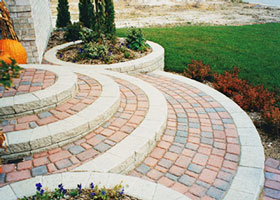More ACE Tips and Techniques - 'How to Lay Pavers'
Base preparation is the most important step. The excavation depth should accommodate the following:
PATIOS & WALK WAYS
- 4-6” 2A Modified stone or 3/4” crushed concrete base (# 10 screenings are not acceptable for base)
- 1” screeded sand bed (# 10 screenings are not acceptable for sand bed) must be concrete sand.
- 2 3/8” Paver of style & color choice
DRIVEWAYS

- 8-10” 2A Modified stone or 3/4” crushed concrete base (# 10 screenings are not acceptable for base)
- 1” screeded sand bed (# 10 screenings are not acceptable for sand bed) must be concrete sand.
- 2 3/8” Paver of style & color choice
After the pitch of the final brick grade is determined and the area is excavated 6“ wider and longer than the actual brickfield and to the proper depth, the sub grade (or bottom of the excavation) is compacted with a plate tamper.
A separation fabric is laid into the excavation covering the bottom and the side walls. The fabric ensures that the stone does not become mixed with the sub soil during compaction.
The base stone is then brought in and graded in 2 to 3 “lifts.” A lift is a term for a compacted layer of stone at a 2-3” depth. If a project that requires 6” of base stone is not compacted in lifts (all stone brought in and compacted on top) only the top 3” of stone will achieve complete compaction and brick settlement may occur.
Once the stone base is graded and compacted to within 3” of the final brick grade, 1” thick metal screed rails (poles) are placed on the base at 4-6’ intervals. Concrete sand is then distributed over and between the rails and a straight screed board is drug over them to create a smooth even layer of sand. The poles are removed and sand is filled into the voids prior to brick laying.
The paver bricks are now laid in the agreed pattern and all non-supported brick edges are restrained.
A thin layer of mason sand is coated over the installed brick surface. Then a plate tamper is used again to set and lock the bricks. As the bricks are forced down by the pressure, the sand below is forced up (displacement) through the seams and the sand on top settles down. This is where the inter-lock takes place. (hence the name “interlocking brick pavers“) More sand is swept into the surface seams until completely full from top to bottom of brick.
Care and Maintenance

Keeping pavers free of debris with regular sweeping will help maintain your pavers original beauty. The frequency of cleaning sealed pavers depends on the amount of traffic and stains they receive. Using a cleaning solution on a regular basis helps prevent stubborn stains from penetrating, making them difficult to remove later.
$14.00 PER SQUARE FOOT (price depends on brand of material, style of material, size of job and condition of work area)